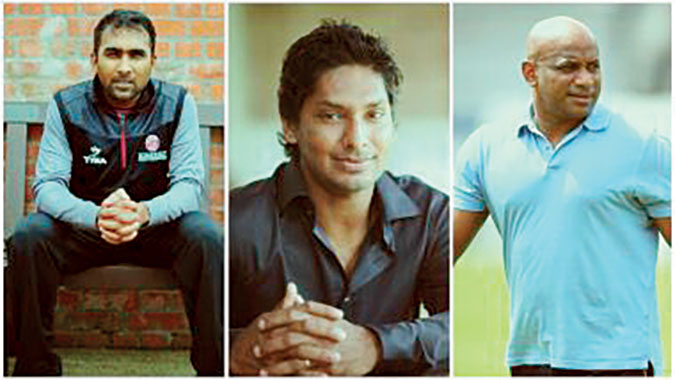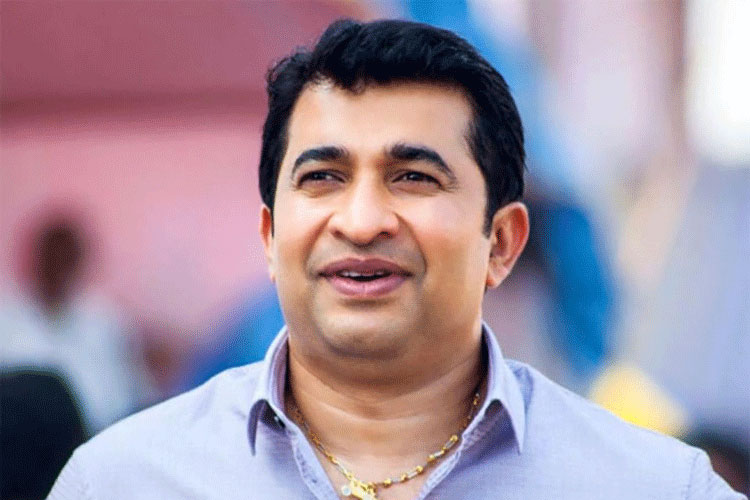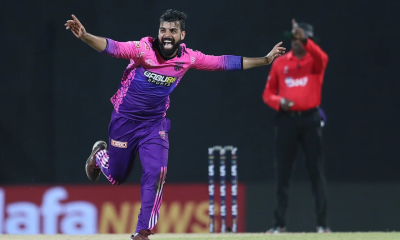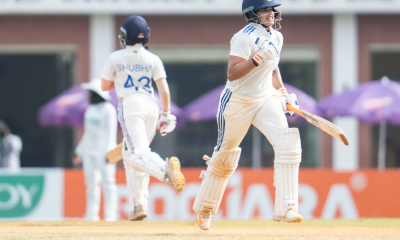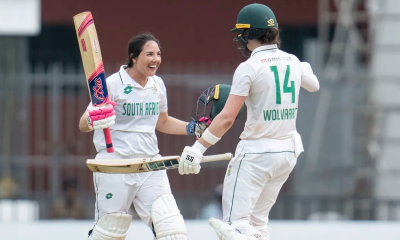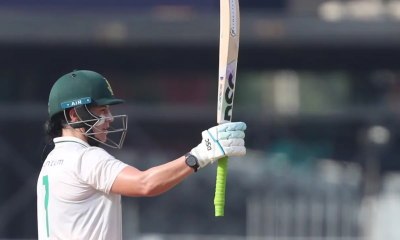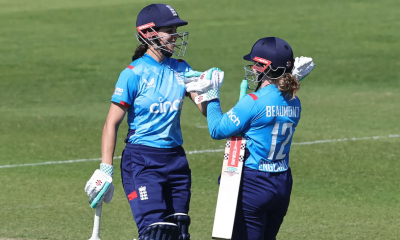Features
Cricketing woes: a need to return to glory from the doldrums
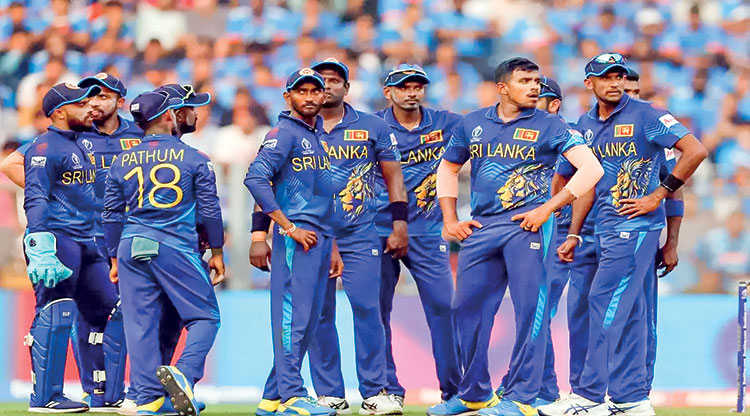
by Dr. Upatissa Pethiyagoda.
The period of mourning is over, and it is open season for the hunt. Our cricket team is back. No VIP lounge, no garlands, no welcoming parties and no open decked bus for a ‘victory ride’ into town, roads lined with cheering, flag waving and delirious crowds. Instead, a grim arrival with no asininely grinning officials from SL Cricket or Ministry of Sports – even perhaps the great man himself.
Little wonder, since Board and Ministry are busy, having instead to face a slew of court proceedings. A combative minister and an unruly Parliament, are floundering in unfamiliar territory, in a manner that is all but sportsman-like. Meanwhile, the Speaker, in his flabby, out-sized finery, fumbles helplessly – rather like a football referee who has forgotten to bring his whistle.
Among those blamed for the debacle are The Board of Control for Cricket (BCCL), coaches, advisors, selectors, poor pitch preparation, punishing schedules, excessive travels, fitness, and evening dew. Everything other than lack of preparedness and dedication by the cricketers themselves. Talent alone without commitment is not enough. Poor captaincy, irresponsible batting, wayward bowling, poor ground fielding and dropped catches have all conspired to diminish performance. Catches do win matches.
The tragedy is that some of these criticisms are valid, but some not so. Compounding all this is the “choking atmosphere” at the Sri Lanka Cricket Board. Various matters are pending in courts. This does not bode well for our cricket and tends to quench any efforts to improve matters.
There are three areas of life which are strictly personal and not open to trespass by anyone. These three are Sports, Religion, and Culture (and may also include language). Wherever they have been trespassed, there has been chaos. What Sport one favours, what religion one follows and what culture one displays, (and I would add, what language one chooses to speak), are not matters to be decided by some certifiable punks. Most of us, I believe, like to make their own choices (or mistakes).
To my mind, the primary cause for the decline of cricket, along with monetization, is politicization. It is astonishing that we have chosen to entrust sports to persons who are unable to conduct even their own legitimate tasks with competence, grace and dignity.
Is it not an absurdity that some guy, bereft of any knowledge or competence, has the power to decide who should be or not be in a national team? Some persons of dubious ability in anything, have been “Ministers of Sports”. The belief that a Minister or Ministry is necessary for things to improve, is a demonstrable fallacy.
When it comes to cricket, I can only think of one instance where high -level political monkeying helped. This was when Sanath Jayasuriya was hurriedly dispatched to bolster our team (in Australia?), when he virtually rushed from airport to grounds, to score a memorable hundred. But see what happened, when the same person chose to enter the murky pitch of local politics.
A world class left-hand opening batsman transformed into a mere third level political nonentity. It is nearly forgotten that he and “Little Kalu” spectacularly re-wrote the syllabus for the first ten overs of ODI cricket, for others to follow. After his defection, Sanath’s only victim was one injured buffalo on the Southern expressway.
In contrast Aravinda, still occupies an enviable place in cricket lore. Murali, Mahela and Sanga are still in equally hallowed positions. Dilshan, perhaps our best ever covers fielder, dropped some hints of a suicidal dive. Fortunately, it seems that his vision for change has now lost its sheen. It is nice to see Arjuna R showing glimpses of his legendary belligerent (cool) obstinacy, whether dealing with port labour or with shady characters in the SL Cricket Board, whose actions have been sadly lacking in integrity. One awaits the findings of the judiciary.
The ongoing duel between President Wickremesinghe and his Sports Minister Roshan Ranasinghe, shows what happens when politics and sports are mixed, when expediency prevails against principle.
Decades ago English and Australian Test teams on their journeys, would fit in a one-day fixture against a local team. Although usually mauled, we sometimes displayed respectable talent (for example in Mahes Rodrigo). During Test Matches we usually backed the Aussies. Our keenness was so intense, that we often recalled the entire score board, even in some County matches. Several Sri Lankans figured respectably in English County Cricket. Two names that come to mind are (Laddie?) Outschoorn and Stanley Jayasinghe, while Gamini.Gunasena and Vijaya Malalasekera excelled in the Oxford/Cambridge Big Matches.
Our current poor showing, has been equated with what Windies cricket has undergone, due to differences, between players and their Governing Body, in financial matters. Although the circumstances are most unfortunate, the mere grouping of us with them, even in distress, is immensely comforting. Most so, when the similarity between them is their bold approaches to the game, without undue regard for the final result, have been admired by many commentators. In particular, the willlngness to take defeat as gracefully as victory, I therefore take the liberty of recalling some of their previous greatness, flattered as we are by the declaration of their similarities.
West Indian Teams excluded coloured players for a long while. After liberation, they blazed a fantastic trail. The front runner in the ‘resurrection’ was Learie. Constantine. After ending his brilliant career in cricket, he was the West Indies High Commissioner to Britain for a few years. He was not only made a knight thereafter, but also served in the House of Lords as “Lord Baron Contantine”.
He was a strong force in combating colour discrimination. In cricket, he was an aggressive batsman and also regarded as the best fielder in Test Cricket in his time. Among the many legends that are associated with L.C, was that he batted with such ferocity that in one instance, it is said that the ball fractured the hand of the hapless quickie bowler who tried to catch it, and then smashed into the front rows of the stands, for one of the lowest sixes ever seen.
The decade of the 1950’s could rightly be called the Age of the Windies. Including perhaps the best all-rounder of all times, Garfield (Gary) Sobers, (who incidentally had a short stint coaching our national team). He was part of the outfit which included the three genius batsmen, Frank Worrell, Clyde Walcott and Everton Weekes (The three W’s), Rohan Kanhai who would steer the ball for a brilliant hook shot, while air-borne, with both feet off the ground. The spin combination of the magical duo, Sonny Ramadhin and Alf Valentine were devils incarnate. The fast bowler Wes Hall, who started his run-up almost from the boundary, was plain deadly.
An important innovation of the time, was the twist of the bat as it struck the ball. This often defined “style”- being maximum effect from minimal effort. Expectedly, this team was heroic to all followers of the game. These were early days for television. I still recall watching a match, where Worrell was on screen continuously for well over ten hours. A historic Fifth Test at Lords, saw all three W’s score ducks. I had the pleasure of meeting Walcott in Rome, when I took mischievous glee in recalling this unique experience. I could not say whether he blushed.
A bit of physics of motion may be in order. A moving body at 60 miles per hour travels 88 feet per second. This means that the 22 yards between bowling and batting crease, is covered in about 0.75 of a second. It is said that the human eye takes about 0.1 second to transmit an impulse from eye to muscle to react. This leaves about 0.65 of a second for a batsman to adjust himself to read the grip on the ball, read the seam position, sense the speed and length, select the proper stroke for the delivery, figure out the fielders’ positions, positioning himself accordingly to play the selected stroke. This is a near impossibility, since faster bowlers today exceed 140 km per hour. It may explain why good batsmen are so rare and that generally, dark-skinned races produce better players than Caucasians. Genetics in operation, physics of motion in error, or some mystical elements at play?
Much has happened to cricket in the last few years. Test cricket, which was the undisputed “King Cricket,” has been displaced by the shorter limited over forms. The 50-over One Day Internationals (ODI) and the 20-over forms (20- overs) have grown in popularity. The almost religious addiction to hallowed (and slower-paced) Tests, is being seriously challenged.
The fear that this might lead to a decline in the quality or “style” has not happened. A type of new culture has developed. This has led to Premier League contests (IPL, PPL and LPL), hosted by India, Pakistan and Sri Lanka respectively. Simultaneously, emphasis has moved towards greater numbers of “professional players”.
There may be some who consider this as likely to diminish the outstanding stature of cricket. The annual fixture in England, between the “Gentlemen” (amateurs) versus “Players” (professionals), was a symbolic recognition of this distinction. This has led to the “Premier League” matches, where players are selected at an auction and drawn from all countries with individual offerings.
The purists may (justifiably) see a parallel with cattle auctions. Cricket, has thus become Big Money, with outstandingly gifted players attracting huge sums, of the order of thousands of dollars (or crores of Indian rupees), for a single season. Players from all playing nations can offer themselves for bids. While some purists might see this as retrograde, the majority view this as just reward for talent and/or entertainment, as so many actors and artists of excellence do. But this also opens the gate for gamblers, match fixers and other crooked types. In fact, some outstanding players have had to sacrifice promising careers for tainted money. The sums involved are astronomical and so also are corresponding corrupt practices.
“Modernization” has brought with it several changes.
Protective gear. The previous gear for batsmen has been added to by helmets, knee and arm protector and thigh paddings. Close-up fielders too wear helmets and shin-guards.Whites have replaced the red leather balls. This has apparently caused differences in bounce and swing. They also seem to wear and soften differently. A sensible change is for each umpire to carry a ball, so that at the end of each over, a different ball is used.
Electronic devices – cameras, ball trackers etc. which are designed to correct possible umpiring errors, and the Duckworth-Lewis Method to combat bad weather, or other reason to curtail the second innings in a limited overs game are useful innovations.
Women’s participation. In also a welcome change. There are events parallel to men’s contests in use. This is most logical. The readiness with which women have risen to the occasion and shown that they are no second to men in performance, is astonishing. It will probably not be too long before fixtures between them, or mixed teams become a reality. Sri Lankan ladies are happily in the top slots. They have figured also as commentators, umpires and scorers and shown to be serious.
Along with the dominance of the shorter versions, the rigour of Test garb has changed from the formal whites and flannels to vivid colours.
There have been some linguistic changes as well to reflect gender equality. No longer are there “batsmen” and “fieldsmen” but “batters” and “fielders”, but still slips and gullies, long, short and fine “legs”.
In our case, new “outstation” talent especially from rural areas, have benefitted the game. Gone are the times when Royal, St Thomas and Trinity provided the nucleus. This is no more. Lads from the most remote areas of the South and North-Central areas dominate. This is undoubtedly a positive development.Teams from the Netherlands and Afghanistan have moved smoothly from the ranks of “Minnows” to serious contenders for recognition.
.
Features
A plural society requires plural governance

The local government elections that took place last week saw a consolidation of the democratic system in the country. The government followed the rules of elections to a greater extent than its recent predecessors some of whom continue to be active on the political stage. Particularly noteworthy was the absence of the large-scale abuse of state resources, both media and financial, which had become normalised under successive governments in the past four decades. Reports by independent election monitoring organisations made mention of this improvement in the country’s democratic culture.
In a world where democracy is under siege even in long-established democracies, Sri Lanka’s improvement in electoral integrity is cause for optimism. It also offers a reminder that democracy is always a work in progress, ever vulnerable to erosion and needs to be constantly fought for. The strengthening of faith in democracy as a result of these elections is encouraging. The satisfaction expressed by the political parties that contested the elections is a sign that democracy in Sri Lanka is strong. Most of them saw some improvement in their positions from which they took reassurance about their respective futures.
The local government elections also confirmed that the NPP and its core comprising the JVP are no longer at the fringes of the polity. The NPP has established itself as a mainstream party with an all-island presence, and remarkably so to a greater extent than any other political party. This was seen at the general elections, where the NPP won a majority of seats in 21 of the country’s 22 electoral districts. This was a feat no other political party has ever done. This is also a success that is challenging to replicate. At the present local government elections, the NPP was successful in retaining its all-island presence although not to the same degree.
Consolidating Support
Much attention has been given to the relative decline in the ruling party’s vote share from the 61 percent it secured in December’s general election to 43 percent in the local elections. This slippage has been interpreted by some as a sign of waning popularity. However, such a reading overlooks the broader trajectory of political change. Just three years ago, the NPP and its allied parties polled less than five percent nationally. That they now command over 40 percent of the vote represents a profound transformation in voter preferences and political culture. What is even more significant is the stability of this support base, which now surpasses that of any rival. The votes obtained by the NPP at these elections were double those of its nearest rival.
The electoral outcomes in the north and east, which were largely won by parties representing the Tamil and Muslim communities, is a warning signal that ethnic conflict lurks beneath the surface. The success of the minority parties signals the different needs and aspirations of the ethnic and religious minority electorates, and the need for the government to engage more fully with them. Apart from the problems of poverty, lack of development, inadequate access to economic resources and antipathy to excessive corruption that people of the north and east share in common with those in other parts of the country, they also have special problems that other sections of the population do not have. These would include problems of military takeover of their lands, missing persons and persons incarcerated for long periods either without trial or convictions under the draconian Prevention of Terrorism Act (which permits confessions made to security forces to be made admissible for purposes of conviction) and the long time quest for self-rule in the areas of their predominance
The government’s failure to address these longstanding issues with urgency appears to have caused disaffection in electorate in the north and east. While structural change is necessarily complex and slow, delays can be misinterpreted as disinterest or disregard, especially by minorities already accustomed to marginalisation. The lack of visible progress on issues central to minority communities fosters a sense of exclusion and deepens political divides. Even so, it is worth noting that the NPP’s vote in the north and east was not insignificant. It came despite the NPP not tailoring its message to ethnic grievances. The NPP has presented a vision of national reform grounded in shared values of justice, accountability, development, and equality.
Translating electoral gains into meaningful governance will require more than slogans. The failure to swiftly address matters deemed to be important by the people of those areas appears to have cost the NPP votes amongst the ethnic and religious minorities, but even here it is necessary to keep matters in perspective. The NPP came first in terms of seats won in two of the seven electoral districts of the north and east. They came second in five others. The fact that the NPP continued to win significant support indicates that its approach of equity in development and equal rights for all has resonance. This was despite the Tamil and Muslim parties making appeals to the electorate on nationalist or ethnic grounds.
Slow Change
Whether in the north and east or outside it, the government is perceived to be slow in delivering on its promises. In the context of the promise of system change, it can be appreciated that such a change will be resisted tooth and nail by those with vested interests in the continuation of the old system. System change will invariably be resisted at multiple levels. The problem is that the slow pace of change may be seen by ethnic and religious minorities as being due to the disregard of their interests. However, the system change is coming slow not only in the north and east, but also in the entire country.
At the general election in December last year, the NPP won an unprecedented number of parliamentary seats in both the country as well as in the north and east. But it has still to make use of its 2/3 majority to make the changes that its super majority permits it to do. With control of 267 out of 339 local councils, but without outright majorities in most, it must now engage in coalition-building and consensus-seeking if it wishes to govern at the local level. This will be a challenge for a party whose identity has long been built on principled opposition to elite patronage, corruption and abuse of power rather than to governance. General Secretary of the JVP, Tilvin Silva, has signaled a reluctance to form alliances with discredited parties but has expressed openness to working with independent candidates who share the party’s values. This position can and should be extended, especially in the north and east, to include political formations that represent minority communities and have remained outside the tainted mainstream.
In a plural and multi-ethnic society like Sri Lanka, democratic legitimacy and effective governance requires coalition-building. By engaging with locally legitimate minority parties, especially in the north and east, the NPP can engage in principled governance without compromising its core values. This needs to be extended to the local government authorities in the rest of the country as well. As the 19th century English political philosopher John Stuart Mill observed, “The worth of a state in the long run is the worth of the individuals composing it,” and in plural societies, that worth can only be realised through inclusive decision-making.
by Jehan Perera
Features
Commercialising research in Sri Lanka – not really the healthiest thing for research

In the early 2000s, a colleague, returning to Sri Lanka after a decade in a research-heavy first world university, complained to me that ‘there is no research culture in Sri Lanka’. But what exactly does having a ‘research culture’ mean? Is a lot of funding enough? What else has stopped us from working towards a productive and meaningful research culture? A concerted effort has been made to improve the research culture of state universities, though there are debates about how healthy such practices are (there is not much consideration of the same in private ‘universities’ in Sri Lanka but that is a discussion for another time). So, in the 25 years since my colleague bemoaned our situation, what has been happening?
What is a ‘research culture’?
A good research culture would be one where we – academics and students – have the resources to engage productively in research. This would mean infrastructure, training, wholesome mentoring, and that abstract thing called headspace. In a previous Kuppi column, I explained at length some of the issues we face as researchers in Sri Lankan universities, including outdated administrative regulations, poor financial resources, and such aspects. My perspective is from the social sciences, and might be different to other disciplines. Still, I feel that there are at least a few major problems that we all face.
Number one: Money is important.
Take the example American universities. Harvard University, according to Harvard Magazine, “received $686.5 million in federally sponsored research grants” for the fiscal year of 2024 but suddenly find themselves in a bind because of such funds being held back. Research funds in these universities typically goes towards building and maintenance of research labs and institutions, costs of equipment, material and other resources and stipends for graduate and other research assistants, conferences, etc. Without such an infusion of money towards research, the USA would not have been able to attracts (and keeps) the talent and brains of other countries. Without a large amount of money dedicated for research, Sri Lankan state universities, too, will not have the research culture it yearns for. Given the country’s austere economic situation, in the last several years, research funds have come mainly from self-generated funds and treasury funds. Yet, even when research funds are available (they are usually inadequate), we still have some additional problems.
Number two: Unending spools of red tape
In Sri Lankan universities red tape is endless. An MoU with a foreign research institution takes at least a year. Financial regulations surrounding the award and spending of research grants is frustrating.
Here’s a personal anecdote. In 2018, I applied for a small research grant from my university. Several months later, I was told I had been awarded it. It comes to me in installments of not more than Rs 100,000. To receive this installment, I must submit a voucher and wait a few weeks until it passes through various offices and gains various approvals. For mysterious financial reasons, asking for reimbursements is discouraged. Obviously then, if I were working on a time-sensitive study or if I needed a larger amount of money for equipment or research material, I would not be able to use this grant. MY research assistants, transcribers, etc., must be willing to wait for their payments until I receive this advance. In 2022, when I received a second advance, the red tape was even tighter. I was asked to spend the funds and settle accounts – within three weeks. ‘Should I ask my research assistants to do the work and wait a few weeks or months for payment? Or should I ask them not to do work until I get the advance and then finish it within three weeks so I can settle this advance?’ I asked in frustration.
Colleagues, who regularly use university grants, frustratedly go along with it; others may opt to work with organisations outside the university. At a university meeting, a few years ago, set up specifically to discuss how young researchers could be encouraged to do research, a group of senior researchers ended the meeting with a list of administrative and financial problems that need to be resolved if we want to foster ‘a research culture’. These are still unresolved. Here is where academic unions can intervene, though they seem to be more focused on salaries, permits and school quotas. If research is part of an academic’s role and responsibility, a research-friendly academic environment is not a privilege, but a labour issue and also impinges on academic freedom to generate new knowledge.
Number three: Instrumentalist research – a global epidemic
The quality of research is a growing concern, in Sri Lanka and globally. The competitiveness of the global research environment has produced seriously problematic phenomena, such as siphoning funding to ‘trendy’ topics, the predatory publications, predatory conferences, journal paper mills, publications with fake data, etc. Plagiarism, ghost writing and the unethical use of AI products are additional contemporary problems. In Sri Lanka, too, we can observe researchers publishing very fast – doing short studies, trying to publish quickly by sending articles to predatory journals, sending the same article to multiple journals at the same time, etc. Universities want more conferences rather than better conferences. Many universities in Sri Lanka have mandated that their doctoral candidates must publish journal articles before their thesis submission. As a consequence, novice researchers frequently fall prey to predatory journals. Universities have also encouraged faculties or departments to establish journals, which frequently have sub-par peer review.
Alongside this are short-sighted institutional changes. University Business Liankage cells, for instance, were established as part of the last World Bank loan cycle to universities. They are expected to help ‘commercialise’ research and focuses on research that can produce patents, and things that can be sold. Such narrow vision means that the broad swathe of research that is undertaken in universities are unseen and ignored, especially in the humanities and social sciences. A much larger vision could have undertaken the promotion of research rather than commercialisation of it, which can then extend to other types of research.
This brings us to the issue of what types of research is seen as ‘relevant’ or ‘useful’. This is a question that has significant repercussions. In one sense, research is an elitist endeavour. We assume that the public should trust us that public funds assigned for research will be spent on worth-while projects. Yet, not all research has an outcome that shows its worth or timeliness in the short term. Some research may not be understood other than by specialists. Therefore, funds, or time spent on some research projects, are not valued, and might seem a waste, or a privilege, until and unless a need for that knowledge suddenly arises.
A short example suffices. Since the 1970s, research on the structures of Sinhala and Sri Lankan Tamil languages (sound patterns, sentence structures of the spoken versions, etc.) have been nearly at a standstill. The interest in these topics are less, and expertise in these areas were not prioritised in the last 30 years. After all, it is not an area that can produce lucrative patents or obvious contributions to the nation’s development. But with digital technology and AI upon us, the need for systematic knowledge of these languages is sorely evident – digital technologies must be able to work in local languages to become useful to whole populations. Without a knowledge of the structures and sounds of local languages – especially the spoken varieties – people who cannot use English cannot use those devices and platforms. While providing impetus to research such structures, this need also validates utilitarian research.
This then is the problem with espousing instrumental ideologies of research. World Bank policies encourage a tying up between research and the country’s development goals. However, in a country like ours, where state policies are tied to election manifestos, the result is a set of research outputs that are tied to election cycles. If in 2019, the priority was national security, in 2025, it can be ‘Clean Sri Lanka’. Prioritising research linked to short-sighted visions of national development gains us little in the longer-term. At the same time, applying for competitive research grants internationally, which may have research agendas that are not nationally relevant, is problematic. These are issues of research ethics as well.
Concluding thoughts
In moving towards a ‘good research culture’, Sri Lankan state universities have fallen into the trap of adopting some of the problematic trends that have swept through the first world. Yet, since we are behind the times anyway, it is possible for us to see the damaging consequences of those issues, and to adopt the more fruitful processes. A slower, considerate approach to research priorities would be useful for Sri Lanka at this point. It is also a time for collective action to build a better research environment, looking at new relationships and collaborations, and mentoring in caring ways.
(Dr. Kaushalya Perera teaches at the Department of English, University of Colombo)
Kuppi is a politics and pedagogy happening on the margins of the lecture hall that parodies, subverts, and simultaneously reaffirms social hierarchies.
By Kaushalya Perera
Features
Melantha …in the spotlight

 Melantha Perera, who has been associated with many top bands in the past, due to his versatility as a musician, is now enjoying his solo career, as well … as a singer.
Melantha Perera, who has been associated with many top bands in the past, due to his versatility as a musician, is now enjoying his solo career, as well … as a singer.
He was invited to perform at the first ever ‘Noon2Moon’ event, held in Dubai, at The Huddle, CityMax Hotel, on Saturday, 3rd May.
It was 15 hours of non-stop music, featuring several artistes, with Melantha (the only Sri Lankan on the show), doing two sets.
According to reports coming my way, ‘Noon2Moon’ turned out to be the party of the year, with guests staying back till well past 3.00 am, although it was a 12.00 noon to 3.00 am event.

Having Arabic food
Melantha says he enjoyed every minute he spent on stage as the crowd, made up mostly of Indians, loved the setup.
“I included a few Sinhala songs as there were some Sri Lankans, as well, in the scene.”
Allwyn H. Stephen, who is based in the UAE, was overjoyed with the success of ‘Noon2Moon’.
Says Allwyn: “The 1st ever Noon2Moon event in Dubai … yes, we delivered as promised. Thank you to the artistes for the fab entertainment, the staff of The Huddle UAE , the sound engineers, our sponsors, my supporters for sharing and supporting and, most importantly, all those who attended and stayed back till way past 3.00 am.”

Melantha:
Dubai and
then Oman
Allwyn, by the way, came into the showbiz scene, in a big way, when he featured artistes, live on social media, in a programme called TNGlive, during the Covid-19 pandemic.
After his performance in Dubai, Melantha went over to Oman and was involved in a workshop – ‘Workshop with Melantha Perera’, organised by Clifford De Silva, CEO of Music Connection.
The Workshop included guitar, keyboard and singing/vocal training, with hands-on guidance from the legendary Melantha Perera, as stated by the sponsors, Music Connection.
Back in Colombo, Melantha will team up with his band Black Jackets for their regular dates at the Hilton, on Fridays and Sundays, and on Tuesdays and Thursdays at Warehouse, Vauxhall Street.
Melantha also mentioned that Bright Light, Sri Lanka’s first musical band formed entirely by visually impaired youngsters, will give their maiden public performance on 7th June at the MJF Centre Auditorium in Katubadda, Moratuwa.
-

 Features3 days ago
Features3 days agoSAITM Graduates Overcome Adversity, Excel Despite Challenges
-

 Latest News6 days ago
Latest News6 days agoNPP win Maharagama Urban Council
-

 Business6 days ago
Business6 days agoJohn Keells Properties and MullenLowe unveil “Minutes Away”
-

 Sports3 days ago
Sports3 days agoASBC Asian U22 and Youth Boxing Championships from Monday
-

 News3 days ago
News3 days agoDestined to be pope:Brother says Leo XIV always wanted to be a priest
-

 Foreign News4 days ago
Foreign News4 days agoMexico sues Google over ‘Gulf of America’ name change
-

 Opinion6 days ago
Opinion6 days agoRatmalana: An international airport without modern navigational and landing aids
-

 Opinion3 days ago
Opinion3 days agoDrs. Navaratnam’s consultation fee three rupees NOT Rs. 300


